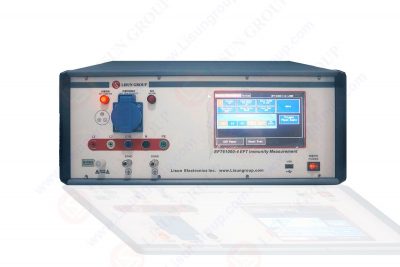
Introduction to EFT Immunity Measurement Electromagnetic Compatibility (EMC) is a crucial factor in the design and operation of electrical and electronic equipment. One of the significant aspects of EMC testing is the ability of a device to resist Electromagnetic Interference (EMI) caused by electrical fast transients (EFT), often referred to as Electrical Fast Transient/Burst Immunity. EFT immuni...

Electromagnetic compatibility (EMC) testing plays a crucial role in ensuring the safety and reliability of electronic devices. The EFT (Electrical Fast Transient) test is a vital component of EMC testing that assesses the immunity of electronic equipment to fast transients and electrical disturbances. This paper focuses on the detailed analysis of EFT testing using the LISUN EFT61000-4 EFT Immunit...

I. Introduction EFT Immunity Measurement is an interference simulation generator for electronic products and is an instrument for the quick transient burst pulse anti-interference test, as well as a kind of electromagnetic compatibility anti-interference test instrument, which is used to testthe resistance of electronic and electrical systems to quick transient interference. This quick transient b...

The burst generator is also called burst tester, is a kind of EMI filter, and its name comes from the “Electrical Fast Transient/burst” (abbreviated as EFT) experiment. The EFT experiment is an immunity test experiment, which is divided into four levels according to the IEC61000-4-4 standard. Different levels of EFT generators have different injection voltages or cargo coupling voltage...

LISUN EFT61000-4 EFT immunity tester is specially designed according to the characteristics and requirements of EFT measurement and it is an ideal disturbance source of EMS measurement. It has fine performance, such as high stability, high reliability, easy to use etc. It meets the standards requirements of IEC 61000-4-4, EN 61000-4-4, GB/T17215.301, GB/T17215.322 and GB/T17626.4. EFT61000-4...

The terms electromagnetic compatibility (EMC) and electromagnetic interference are often used interchangeably when talking about the testing of commercial electronic goods and products. Because the two types of tests share so many similarities, it’s very easy to confuse one with the other. In this article, we will attempt to highlight some of the major differences between EMC and EMI testing. We...

The origin of the EFT pulse generator: In industrial process measurement and control devices, when the inductive load is disconnected, a transient pulse group (string) of several thousand volts will be generated at the breakpoint, and this disturbance will be conducted through the power line or signal line (some Radiation) enters the measurement and control device, causing the digital circuit o...

In addition to the selection and circuit design of components, good printing circuit board (PCB) design is also a very important factor in electromagnetic compatibility. The key to the design of PCB in EMC is to reduce the return area as much as possible and let the return path flow in the direction of the design. The most common return current comes from the cracks of the reference plane, the tra...

1. The mechanism of EFT Immunity Measurement and its impact on electronic products The EFT immunity tester is a transient disturbance generated at the disconnection due to the insulation breakdown of the switch contact gap or the contact bounce when the inductive load (such as relay, contactor, etc.) is disconnected. When the inductive load is repeatedly switched on and off for many times, the pul...

An immunity test called EFT Immunity Measurement (EFT61000-4) is used to evaluate how well electrical and electronic equipment performs when subjected to interference. A device is put through a number of tests to see if it can withstand fast transients like electrostatic discharge and power line transients. Verifying the laboratory’s operating parameters, examining the EFT waveform, running ...

The EFT61000-4 EFT immunity tester is specially designed according to the characteristics and requirements of EFT measurement and it is an ideal disturbance source of EMS measurement. It has fine performance, such as high stability, high reliability, easy to use etc. It meets the standards requirements of IEC 61000-4-4, EN 61000-4-4, GB/T17215.301, GB/T17215.322 and GB/T17626.4. EFT61000-4 h...

When doing IEC 61000-4-4 EFT immunity test, there are L1, L2, L3, N and PE interface. PE and earth are two different concepts. Electrical fast pulse interference is common mode, in the experimental setup figure of the standard, we can see the signal cable which is from the test generator can connect with corresponding power lines (L1, L2, L3 , N and PE) through the selectable coupling capacitor, a...